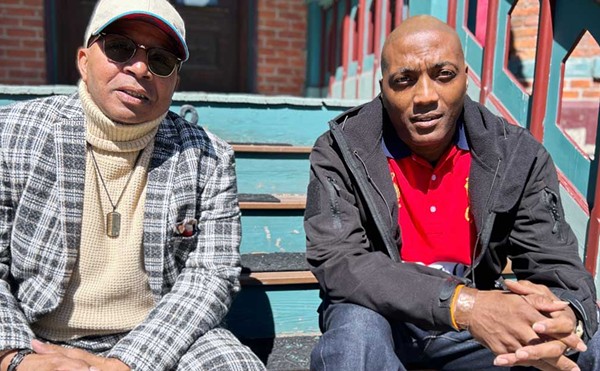Countless visitors (and filmmakers), from both near and far continue to be absolutely enthralled with an almost-mythical Detroit, its buildings, its powerhouse history of the 20th century, its failures — its glorious ruins. Books have been written, theses have been penned and photo essays are continually being composed on this once-grand skyscraper museum, the great modern industrial acropolis known as Detroit. The Michigan Central Train Station, the Book Cadillac, the Broderick Tower, the David Whitney Building, the David Stott Tower, the Statler, the Michigan and UA Theatres — Detroit has one of the most magnificent collections of pre-war skyscrapers and movie palaces in the world, many of which are abandoned, many of which are at risk, a handful of which might be saved.
Conversely, Detroit is also a city whose troubled downtown, when Dennis Archer arrived on the scene in the early 1990s, began a tentative, if hesitating, revival, sometimes at the expense of its skyscrapers and historical structures, while also luring a dazzling bounty of major multimillion-dollar “big ticket” capital investments back into the largely vacant city core.
Mayor Kilpatrick, answering a question before an Urban Land Institute conference in Detroit on Nov. 6, admitted that, when he first arrived in office, his gut reaction was to tear down the “dinosaur” buildings if nobody is using them. Now, however, he acknowledges that, in the course of the “learning process,” there might be some value in renovating these historic structures, provided that it makes financial sense.
The acropolis is resurrecting, sort of. It’s a real-life version of “SimCity,” where you move key pieces around the grid: Stadium projects, loft projects, corporate HQs, casinos, parks, attractions (hell, we even physically dragged the Gem/Century Building to make way for a Comerica Park parking lot). There should be a board game about it. (“Gave Peter Karmanos too many tax breaks to build Compuware’s HQ, go back three spaces and balance the budget” or “Need 40 new snowplows for blizzard, grovel before casinos with hat in hand.” The possibilities are endless.)
The intent of this twice-monthly column, Rubble Rouser, is to keep watch over the game board, to offer a running soapbox commentary on the many projects and prospects which are continually cropping up (and, yes, sometimes failing) in the Detroit development scene, with an emphasis on downtown, where the past is omnipresent, unavoidable and oftentimes a crumbling yet inert force to be reckoned with. The intention here is not, however, to impose some sort of pious building-hugging, mass transit-advocating, controlled-growth-preservationist manifesto on an unsuspecting populace. (Not that there’s anything necessarily wrong with that.)
If there is truly going to be a “renaissance” in this fair city, it certainly wouldn’t hurt to have a running commentary and chronicle on its successes and failures, the individuals involved and the ongoing rumors and dreams that stoke the fires. Rebuilding a city is quite a challenging and fascinating dilemma, particularly when you consider that Detroit is essentially starting from a unique position on what could charitably be dubbed the “ground floor.”
Better days
Nowhere is this more apparent than at the polar ends of the once-majestic promenade known as Washington Boulevard. During its heyday, the Boulevard, and in particular the four-block stretch from Grand Circus Park to Michigan Avenue, with its high-end shopping and upscale hotels, was once regarded as the “Fifth Avenue of the Midwest.” It is now notable as the site of two of the most vexing issues to perplex downtown since the Hudson’s building went cascading into a mushroom cloud of dust: The abandoned hotels known as the Statler and the Book-Cadillac.
Indeed, strolling down Washington Boulevard from the Statler to the Book-Cadillac, what one sees is in many ways emblematic of the paralysis and pratfalls which downtown Detroit has experienced over the past several decades. Start at Grand Circus Park and make your way south to the Book-Cadillac. There’s the David Whitney Building, designed by Daniel Burnham (of the 1893 Chicago World’s Fair and later in charge of the city plan for Chicago), resplendent with its five-story white marble atrium. Slated several years ago for a glitzy Embassy Suites makeover, it now languishes in developmental limbo as tightfisted lending policies and a not-so-rosy economy have converged to dry up the hotel financing market.
Across the street is the once-glorious Statler Hotel, formerly the Italian Renaissance showpiece of the famed Statler Hotel chain, now famous for the tattered red awnings affixed to its facade prior to the 1980 Republican National Convention in a ham-fisted effort to mask the decay inside.
The center of the boulevard is dominated by a universally loathed early 1980s public art project which was spawned by Birmingham-based architect Gino Rosetti (architect of the new Compuware HQ and Ford Field), derisively referred to by local wags as the “Erector Set,” and featuring James Pallas’ art installation tribute to Thomas Edison (think lots of light bulbs). In addition, the boulevard was further sullied by that abject failure of 1970s urban redevelopment planners, the “pedestrian mall,” as well as a bicentennial-era trolley installation which utilized nine turn-of-the-century street trolleys originally used in Lisbon, Switzerland and England (ironic given that Detroit once possessed a thriving beehive of a trolley system — still operating to this day in Mexico City). The “Detroit Citizen’s Railway,” as the mini-trolley system was originally dubbed, while promising in concept, is a woefully underfunded and neglected system.
The Boulevard is home to a mixed bag of businesses, a bit isolated perhaps, but doggedly going about their business. These range from hair salons such as the Golden Goddess and Last Tangle, to Eva’s Attic Room, a secondhand/antique store, to the largely occupied Trolley Plaza apartment tower and ground-level market, to the 18th century St. Aloysius Parish and Archdiocese of Detroit. In between one will find often vacant storefronts, as well as a neutron bomb-style café in the back of the old Himelhoch’s department store, where all of the place settings, faded tablecloths, and dusty glasses continue to sit on the tables waiting for a tea time which has been indefinitely delayed. Looking in the picture windows of the café from Washington Boulevard is like a time capsule glimpse into the Boulevard of years past, except perhaps for the twisted candlesticks on the tables, contorted by years of western exposure to a setting sun.
Tower of strength
Approaching the Book-Cadillac, the grim and oddly charming gothic allure of the Book Tower looms prominently over the west side of the thoroughfare. The Book Building and adjacent Book Tower were constructed in 1917 and 1926, respectively, by the Book Brothers, who were akin to Washington Boulevard’s founding fathers. The Book Brothers, who were actually born on the site of the Book-Cadillac Hotel (which they later constructed), had brought in famed urban planner Edward H. Bennett from Chicago and redeveloped a then-rundown boulevard according to the “City Beautiful” movement then in vogue. This transformation took place between 1916 and 1930, although Depression-era financial difficulties eventually sapped the Book Brothers of much of their capital, as well as putting the kibosh on their planned 81-story tower.
With all of these failed attempts at renewal, Washington Boulevard and its two anchor hotels have languished for much of the past two decades. However recent signs of life have been pushing up through the decay and rubble. The Book Building and Tower have begun to forge their own identity (other than as a glorified communications dish with a smattering of occupied offices) beginning with the Museum of New Art, a Creole restaurant and Soho-style storefront art galleries. In addition, the Book Building will soon house what promises to be a hot new watering hole, Bookie’s, which appears to be taking a cue from the Town Pump in recognizing that bars in the downtown district need not exclusively be dance clubs in order to survive.
But what truly focused attention on Washington Boulevard has been the recent announcements regarding the Book-Cadillac Hotel. Over the course of a mere two short days at the end of October, consecutive blaring front page stories and evening news blabs trumpeted 1) that Hilton and Marriott were vying to redevelop the Book-Cadillac, and 2) that the Marriott group had been chosen for the redevelopment project, with tentative plans for converting the mammoth hotel’s unwieldy 1,200 1920s-era (read: tiny) hotel rooms into 475 modern-day rooms and 95 condos. The whole project is to be financed via a dizzying array of incentives and tax credits, including a brownfields redevelopment zone designation, state Renaissance Zone designation, and a novel extension of the federal Empowerment Zone (EZ), as well as a previously untapped reservoir of bond financing.
What the recent media hype failed to capture with regard to the Book-Cadillac, however, is exactly how and why a project which mostly languished in limbo since 1984 suddenly became big news. The story catapulted onto the front pages as a purported horse race between two international hotel chains, with a winner made public within 24 hours.
Playing the game
In Detroit, such deals do not materialize overnight. While folks within the downtown development acronym world known as the DEGC and DDA (Detroit Economic Growth Corporation and the Downtown Development Authority) have been attempting to put together viable proposals for the Book-Cadillac for some time now, it was not until late last year that locally based Acquest Realty surfaced with a plan. While they were only in the exploratory process, David Ong of Acquest figured theirs was the “only game in town.” Acquest had recently completed a similar project in Trenton, N.J., in partnership with Marriott, successfully forming a nonprofit development entity as a vehicle to raise funds through tax-exempt bonds. Acquest believed it could mount a similar approach with the Book-Cadillac.
Around February of this year, however, Dallas-based Historic Hospitality Investments (HHI) surfaced, along with several other allies (including the formidable Higgins Development group out of Chicago) and began putting together a proposal that would finance the Book-Cadillac redevelopment without leaving the city holding the bag in the event the project went south. HHI is controlled by Kimberly-Clarke, a $15.7 billion company, and the Higgins group is controlled by the Pritzker folks out of Chicago (founders of the Hyatt Hotel chain, among their many interests). Suffice to say, these are not fly-by-night developers, and contrary to the media reports, once Kimberly-Clarke arrived on the scene almost 10 months ago, Acquest was out of the running (which Ong readily acknowledges). As Ong noted, “They are clearly the best team.”
HHI retained heavy-hitting silk stockings law firm Honigman, Miller, Schwartz & Cohn and went to work getting the approval at public hearings for the brownfield and Renaissance Zone tax credits (which could amount to approximately $30 million). The HHI group is also putting in at least $15 million of its own. Finally, and here is where some creative thinking comes into play, it was discovered that, as of Jan. 1, 2002, the EZ had an additional $230 million in untapped tax-exempt bonding capacity available, a source that the city’s economic development and Empowerment Zone officials did not even know existed until HHI alerted them to it. The folks at the DEGC who really wanted to make this project succeed (and they do exist, contrary to what some preservationists fear), set aside around $70 million in that newfound bonding capacity to make this project work.
Getting empowered
Of course, there was one small detail: the Book-Cadillac is not in the EZ. However, there exists a little-explored exception, whereby the EZ can essentially be dropped into the Central Business District like a special-ops strike package of business development incentives, provided the census tract meets the requisite poverty percentage level, which the Book-Cadillac site easily did.
This invites a question: Why didn’t anybody try this before? According to Lynne Fournier, director of tax credit investment for Kimberly-Clarke, while the EZ is, in theory, a great program to encourage private parties to invest in depressed areas, given its Byzantine restrictions and conditions, it is not unusual for cities to not know how to use its bonding capacity. Ong marvels at the HHI group’s proposal to use both the tax credits provided by the Renaissance Zones and brownfields, as well as the EZ tax- exempt bond capacity: “It’s the best of both worlds,” he noted, and “HHI came up with it.”
Moreover, as Fournier and Ong are quick to point out, this is not simply a vault of EZ-cash waiting to be plundered — the bonds still have to be sold, and the inherent concerns of jittery buyers are quickly assuaged when they see a multibillion-dollar conglomerate like Kimberly-Clarke taking the first $15 million plunge and securing the bonds. As Ong notes, the presence of Kimberly-Clarke in the deal is a “unique combination” that few can match, and but for Kimberly-Clarke, “We’d be running with the ball.”
Helping the hood
Given the Book-Cadillac’s proximity to the actual EZ, it only makes sense that the jobs and commerce generated by a viable, fully functioning Book-Cadillac would benefit the EZ residents nearby. Recognizing this potential, HUD has already granted preliminary approval of the EZ extension. Interestingly enough, this heretofore untapped reservoir of EZ bonding capacity had only been used in one other instance, the St. Louis Convention Center and 1,000-plus-room hotel there (also an HHI/Kimberly-Clarke project). According to Fournier, however, it is “conceivable” that the Book-Cadillac financing formula will become an example for future projects in Detroit as well as in EZ’s across the country.
While there still remains a gap of perhaps $14 million in the Book-Cadillac project costs, the financial alchemy that came up with the leading package was indeed impressive, and offers a template for future projects. (Not to mention the newly discovered $160 million in bonding capacity that the EZ will still have to play with if this deal ever goes through.)
What’s clear now, however, is that HHI hasn’t exactly won anything yet. What they have done is sunk at least $500,000 of their cash into this deal already, while also changing the equation in the way we approach these projects. If all goes well, approval on all credits (EZ, Renaissance Zone and brownfields) should be nailed down by Christmas. (Yes, Roger Penske and your Super Bowl Host Committee, there is a Santa Claus.) According to Fournier, if all goes according to plan, the Book-Cadillac Marriott Renaissance will have an opening in the fall 2005, with all sights set on the 2006 Super Bowl.
Locals seeking to preserve the 1920’s streetscape of the boulevard, such as Steve Haag, President of the Friends of the Book-Cadillac, are cautiously optimistic about the renovation plans for the Book-Cadillac. According to Haag: “We believe it shows that the Jazz Age skyscrapers downtown are not white elephants, but keys to making downtown a vibrant place to live, work and do business.”
Unfortunately, however, as the sun begins to rise at one end of the boulevard, it is setting rapidly at the other.
Down the street
An announcement was recently made that the City’s Planning and Development Department was devoting $6 million (courtesy of the State’s Clean Michigan Initiative) to demolish the vacant Statler Hotel, like the Book-Cadillac, an equally grand Italian Renaissance-designed hotel which has suffered from years of neglect after its 60-year run. Ironically, in a curious bit of backward logic, one of the stated purposes was to restore Washington Boulevard to its elegant grandeur of yesteryear (apparently, surface parking lots where majestic 1920s edifices once stood was an endearing charm of bygone eras as well). Sources within the DEGC as well as interested observers caution, however, that the Statler’s demolition is not yet a fait accompli.
According to Steve Haag: “As for the Statler, there may be more interest than is generally noticed. I know that Acquest is turning its attention to the building as sort of a consolation for losing the Book-Cadillac. Along with the availability of the extra EZ revenue bonds, it may not be as difficult to bring the building back as the structural system makes it seem.”
Ong at Acquest was coy when asked about plans for the Statler, only offering that they “have not given it a hard look.” But is there a market for the Statler? While Ong does not dismiss saving the Statler, he does echo the serious concern of many in the industry that there will not be enough of a market, with new casino hotels and a renovated Book-Cadillac, to support yet another hospitality venture.
It should be noted that some prominent architectural firms, Albert Kahn & Associates included, had previously dismissed the Book-Cadillac as beyond saving. Obviously, those opinions were not as solid as the hotel’s steel-and-concrete skeleton. Perhaps the prevailing school of thought on the Statler, and on its questionable structural integrity, could change as well. In any event, the whole episode is perfectly emblematic of what one might call Newton’s Law of Downtown Motion, which, in bastardized form, states that for every positive action (Book-Cadillac redevelopment) there is an equal and opposite negative reaction (ironically, down goes the Statler).
Those that have looked carefully at the Statler question whether, from a purely structural standpoint, it is beyond saving, as many officials have asserted, particularly when one factors in that newfound $130 million in EZ bonding capacity. And, oh, what a glorious and glittering showpiece it would be for the 2006 Super Bowl to have not one, but two, fabulously restored historic hotels to house the global media hordes and visiting dignitaries.
But, then again, that’s a subject for another column.
Friends of the Book-Cadillac, Detroit Synergy Group and friends host a party Dec. 20 (5-8 p.m. at Panacea, W. Congress at Shelby, in downtown Detroit) to celebrate the Book-Cadillac’s revival. A $10 donation is suggested. Author David Kohrman will be on hand to autograph his new book, Detroit’s Statler and Book-Cadillac Hotels, and Save The Book T-shirts.
Read about the development programs that accompany this feature.
Send comments to [email protected]




